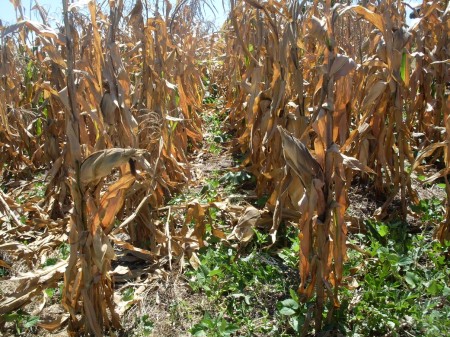Starvation is looming in Zimbabwe after widespread failure of crops coupled by policies that have failed to stimulate economic growth.

A snap survey by the southern African nation’s The Standard newspaper in various parts of the country showed that a large chunk of the staple crop — corn or maize — is now a write off. Irrigation schemes which used to augment the yields are obsolete following years of neglect and vandalism.
“Our crops failed because of poor rainfall. The rains came late after most of the crops had wilted,” said Enock Chirwa, a farmer in Lower Gweru.
According to the Meteorological Service Department, rains started late and were below normal during the entire growing season. The situation is dire in the southern parts of the country where virtually all crops failed.
“The situation is bad here. There is no harvest to talk about. Everything that the farmers planted failed,” said Gwanda Central MP Edison Gumbo, adding: “We are now counting on our livestock considering that we have received rains during this time of the year. We hope our pastures will improve and our dams have enough water to last the dry season.”
The government estimates that nearly 0,3 million hectares of the estimated cultivated area of 1,5 million hectares has been written off. The country needs to import about 1,4 million tonnes of maize to feed the whole nation.
“Given the performance of the season, there is a high possibility that the written off area could be much larger. Official production figures will be available soon when the second-round Crop and Livestock Assessment Report is released,” said World Food Programme (WFP) country director, Sory Ouane.
Ouane said WFP would only know the crop situation after completion of the rural livelihood assessment exercise which is currently underway.
“WFP is informed by the Zimbabwe Vulnerability Assessment Committee [ZimVAC] rural livelihood assessment, which indicates the proportion of food insecurity in the country as well as the affected geographical locations. This process is on-going and is likely to be completed by May 2015. In the absence of any national assessment, it is not possible to estimate the magnitude of the problem and consequently the needs,” he said.
Late last year, the ZimVAC rural livelihoods report indicated that approximately 6% of the rural population required about 21 000 metric tonnes of maize in food assistance at the height of the hunger season between January and March this year. However, indications are that a large chunk of the population in both urban and rural areas would require food aid considering the harvest was poor.
Zimbabwe Farmers’ Union (ZFU) president Abdul Credit Nyathi confirmed that the harvest was small.
“At least 75% of the crop that was planted did not do very well and only a few farmers on irrigation schemes made significant yields,” Nyathi said.
He said ZFU was encouraging farmers to prepare for the next cropping season despite losses they incurred during the previous season.
“We encourage farmers to start preparing for the coming season, while we negotiate for improved producer prices so that those few farmers who harvested get something and cover losses”. Nyathi said the current rains had improved pasture and brought a huge sigh of relief to the livestock sector.
The government has been accused of failing to handle the land distribution programme, among many other policies that the country adopted since independence. Economist John Robertson, speaking at an Institute of Chartered Accountants of Zimbabwe (ICAZ) tax update seminar recently, said there was need for government to craft policies that would support agriculture production.









